Toyota 86 2023 Before driving
Before taking a trip in the 2023 Toyota 86, safety is the most important thing to think about. This sports car is known for its thrilling speed, and it also comes with a number of standard and optional safety features that make driving it safe and easy. These features include the most important ones, such as a strong safety system, anti-lock brakes, and stability control. If you want advanced driver aid, some trims have systems like adaptive cruise control to keep a safe distance between you and the car in front of you, lane departure warning to keep you from drifting out of your lane by accident, and automatic emergency braking to help you avoid accidents. A rearview camera also makes it easier to park and move the car backwards. The safety of children is also a top priority, which is why LATCH pins are used to secure child safety seats. The tire pressure monitoring system (TPMS) keeps a close eye on tire pressure to make sure the tires are healthy and working well. Before leaving, the driver and vehicle are carefully checked, such as by making sure the seatbelts are fastened, fixing the mirrors, and looking at the lights on the outside of the car. When thinking about safety for the 2023 Toyota 86, it’s important to check the brakes, steering wheel, and driver’s seat position to make sure they are set up for comfort and control. This all-around approach shows that the 2023 Toyota 86 is committed to combining thrilling performance with rock-solid safety. It is the essence of a sports car, where driving fun and safety go hand in hand.
Floor mats
Use only floor mats designed specifically for vehicles of the same model and model year as your vehicle. Fix them securely in place onto the carpet.
Insert the retaining hooks (clips) into the floor mat eyelets.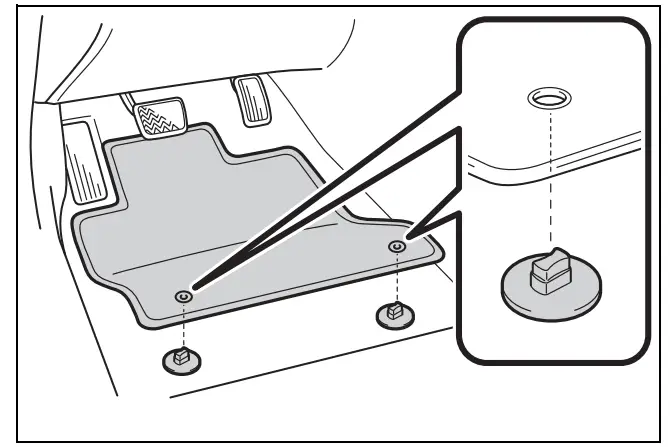 Turn the upper knob of each retaining hook (clip) to secure the floor mats in place.
Turn the upper knob of each retaining hook (clip) to secure the floor mats in place.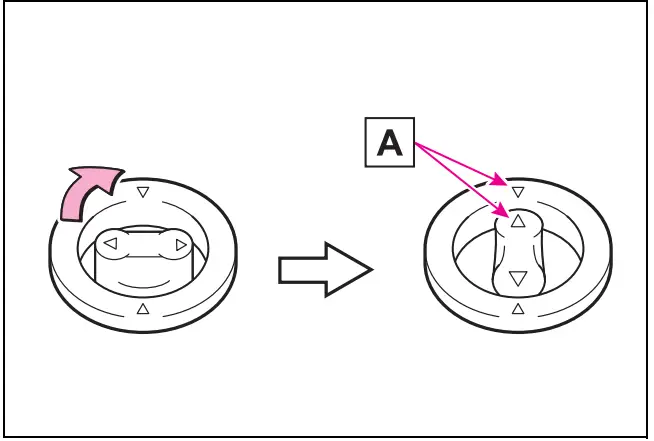
Always align the ![]() marks A.
marks A.
The shape of the retaining hooks (clips) may differ from that shown in the illustration.
WARNING
Observe the following precautions.
Failure to do so may cause the driver’s floor mat to slip, possibly interfering with the pedals while driving. An unexpectedly high speed may result or it may become difficult to stop the vehicle. This could lead to an accident, resulting in death or serious injury.
When installing the driver’s floor mat
- Do not use floor mats designed for other models or different model year vehicles, even if they are Toyota Genuine floor mats.
- Only use floor mats designed for the driver’s seat.
- Always install the floor mat securely using the retaining hooks (clips) provided.
- Do not use two or more floor mats on top of each other.
- Do not place the floor mat bot-tom-side up or upside-down.
WARNING
Before driving
- that the floor mat is securely fixed in the correct place with all the provided retaining hooks (clips). Be especially careful to perform this check after cleaning the floor.
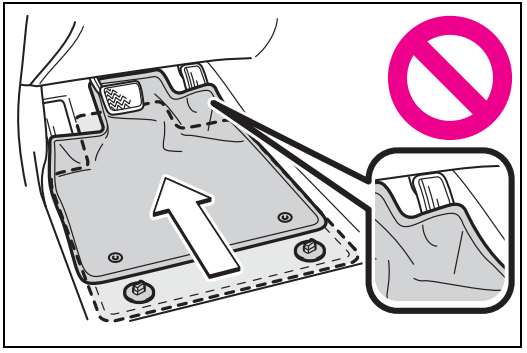
- With the engine stopped and the shift lever in P (Automatic transmission) or N (manual transmission), fully depress each pedal to the floor to make sure it does not interfere with the floor mat.
For safe driving
For safe driving, adjust the seat and mirror to an appropriate position before driving.
Correct driving posture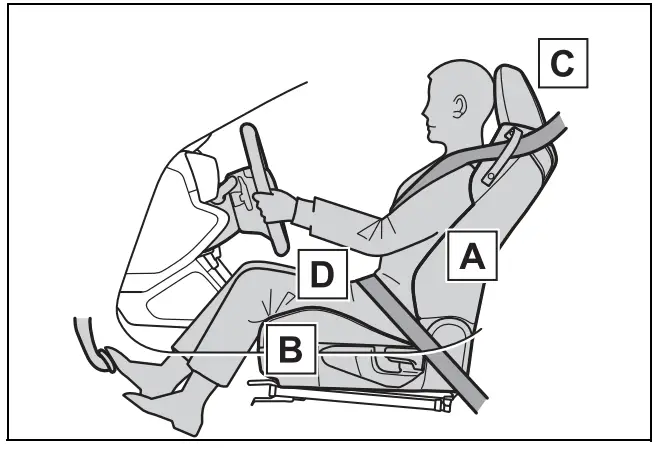
- Adjust the angle of the seat-back so that you are sitting straight up and so that you do not have to lean forward to steer.
- Adjust the seat so that you can depress the pedals fully and so that your arms bend slightly at the elbow when gripping the steering wheel.
- Lock the head restraint in place with the center of the head restraint closest to the top of your ears.
- Wear the seat belt correctly.
WARNING
For safe driving
Observe the following precautions.
Failure to do so may result in death or serious injury.
- Do not adjust the position of the driver’s seat while driving. Doing so could cause the driver to lose control of the vehicle.
- Do not place a cushion between the driver or passenger and the seatback.
A cushion may prevent correct posture from being achieved, and reduce the effectiveness of the seat belt and head restraint. - do not place anything under the front seats.
Objects placed under the front seats may become jammed in the seat tracks and stop the seat from locking in place. This may lead to an accident and the adjustment mechanism may also be damaged. - Always observe the legal speed limit when driving on public roads.
- When driving over long distances, take regular breaks before you start to feel tired. Also, if you feel tired or sleepy while driving, do not force yourself to continue driving and take a break immediately.
Correct use of the seat belts
Make sure that all occupants are wearing their seat belts before driving the vehicle. Use a child restraint system appropriate for the child until the child becomes large enough to properly wear the vehicle’s seat belt.
Adjusting the mirrors
Make sure that you can see backward clearly by adjusting the inside and outside rearview mirrors properly.
Seat belts
Make sure that all occupants are wearing their seat belts before driving the vehicle.
WARNING
Observe the following precautions to reduce the risk of injury in the event of sudden braking, sudden swerving or an accident. Failure to do so may cause death or serious injury.
Wearing a seat belt
- Ensure that all passengers wear seat belts.
- Always wear a seat belt properly.
- Each seat belt should be used by one person only. Do not use a seat belt for more than one person at once, including children.
- Toyota recommends that children be seated in the rear seat and always use a seat belt and/or an appropriate child restraint system.
- To achieve a proper seating position, do not recline the seat more than necessary. The seat belt is most effective when the occupants are sitting up straight and well back in the seats.
- Do not wear the shoulder belt under your arm.
- Always wear your seat belt low and snug across your hips.
Pregnant women
Obtain medical advice and wear the seat belt in the proper way.
Women who are pregnant should position the lap belt as low as possible over the hips in the same manner as other occupants, extending the shoulder belt completely over the shoulder and avoiding belt contact with the rounding of the abdominal area.
If the seat belt is not worn properly, not only the pregnant woman but also the fetus could suffer death or serious injury as a result of sudden braking or a collision.
People suffering illness
Obtain medical advice and wear the seat belt in the proper way.
When children are in the vehicle
Do not allow children to play with seat belts. If the seat belt becomes twisted around a child’s neck, it may lead to choking or other serious injuries that could result in death.
If this occurs and the buckle can-not be unfastened, scissors should be used to cut the belt.
WARNING
Seat belt damage and wear
- Do not damage the seat belts by allowing the belt, plate, or buckle to be jammed in the door.
- Inspect the seat belt system periodically. Check for cuts, fraying, and lose parts. Do not use a damaged seat belt until it is replaced. Damaged seat belts cannot protect an occupant from death or serious injury.
- Ensure that the belt and plate are locked and the belt is not twisted.
If the seat belt does not function correctly, immediately contact your Toyota dealer. - Replace the seat assembly, including the belts, if your vehicle has been involved in a serious accident, even if there is no obvious damage.
- Do not attempt to install, remove, modify, disassemble or dispose of the seat belts. Have any necessary repairs been carried out by your Toyota dealer? Inappropriate handling may lead to incorrect operation.
Correct use of the seat belts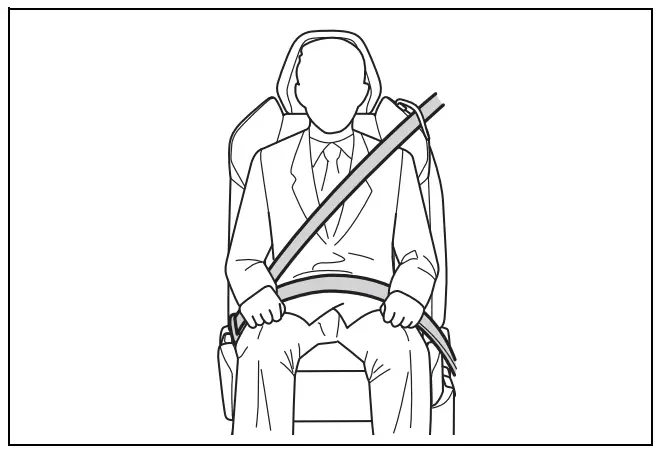
- Extend the shoulder belt so that it comes fully over the shoulder, but does not come into contact with the neck or slide off the shoulder.
- Position the lap belt as low as possible over the hips.
- Adjust the position of the seatback. Sit up straight and well back in the seat.
- Do not twist the seat belt.
Child seat belt usage
The seat belts of your vehicle were principally designed for persons of adult size.
- Use a child restraint system appropriate for the child, until the child becomes large enough to properly wear the vehicle’s seat belt.
- When the child becomes large enough to properly wear the vehicle’s seat belt, follow the instructions regarding seat belt usage.
Fastening and releasing the seat belt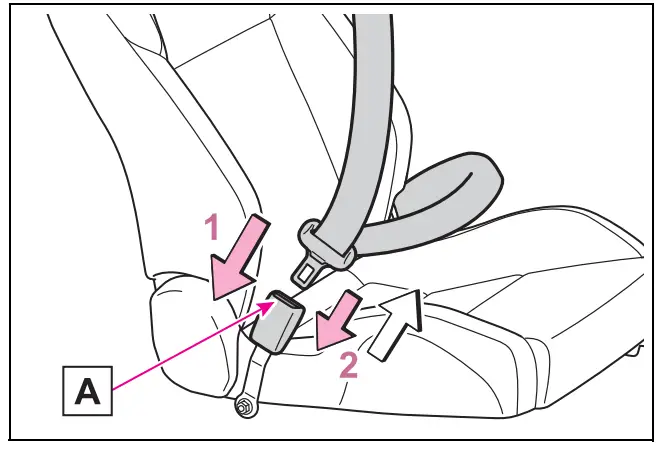
- To fasten the seat belt, push the plate into the buckle until a click sound is heard.
- To release the seat belt, press the release button A .
Emergency locking retractor (ELR)
The retractor will lock the belt during a sudden stop or impact. It may also lock if you lean forward too quickly. When the seat belt locks, pull the belt strongly and then release the belt, then a slow and easy pulling will allow the belt to extend.
Automatic locking retractor (ALR)
When a passenger’s shoulder belt is completely extended and then retracted even slightly, the belt is locked in that position and cannot be extended. This feature is used to hold a child restraint system (CRS) firmly. To free the belt again, fully retract the belt and then pull the belt out once more.
Seat belt guide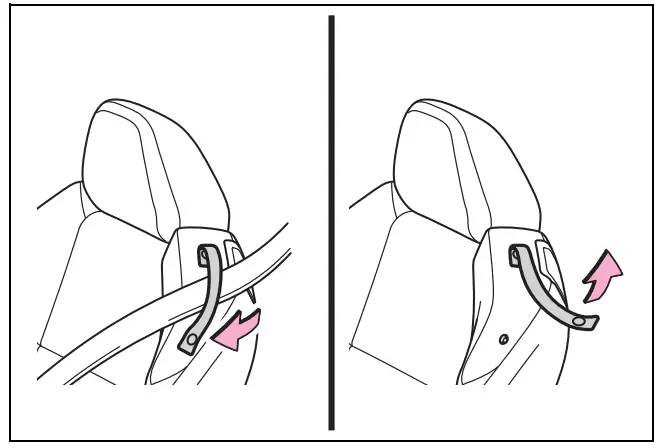
When fastening a front seat belt, ensure that it is passed through the seat belt guide. Passing the seat belt through the guide enables the seat belt to be easily extended.
When you get into or out of the rear seats, release the seat belt from the seat belt guide.
WARNING
- When using the seat belt guide
- Always make sure that the belt is not twisted, and runs freely through the guide.
- Regardless of whether the guide is used or n t, always secure the seat belt guide button.
- Do not hang from or pull the guide forcefully.
Seat belt pretensioners (front seats)
The pretensioners help the seat belts to quickly restrain the occupants by retracting the seat belts when the vehicle is subjected to certain types of a severe frontal collision or a vehicle rollover The front seat belt pre-tensioners also activate when the vehicle is subjected to certain types of a severe side collision. The pretensioners do not activate in the event of a minor frontal impact, a minor side impact, or a rear impact.
Replacing the belt after the pretensioner has been activated
If the vehicle is involved in multiple collisions, the pre-tensioner will activate for the first collision, but will not activate for the second or subsequent collisions.
WARNING
- Seat belt pretensioners
- Do not place anything, such as a cushion, on the front passenger’s seat. Doing so will disperse the passenger’s weight, which prevents the sensor from detecting the passenger’s weight properly. As a result, the seat belt pretensioner for the front passenger’s seat may not activate in the event of a collision.
- If the pretensioner has activated, the SRS warning light will come on. In that case, the seat belt cannot be used again and must be replaced at your Toyota dealer.
SRS airbags
A supplemental Restraint System (SRS) name is used because the airbag system supplements the vehicle’s seatbelts. This vehicle is equipped with a supplemental restraint system which consists of seven airbags. The configurations are as follows.
- Driver’s and front passenger’s frontal airbags
- Driver’s and front passenger’s side airbags
- Curtain shield airbags (for the driver, front passenger and rear passengers)
- Knee airbag for the driver
These SRS airbags are designed only to be a supplement to the primary protection provided by the seatbelt. The system also controls front seatbelt pretensioners. For operation instructions and precautions concerning the seatbelt pre-tensioner.
Components
- Location of the SRS airbags
The SRS airbags are stowed in the following locations.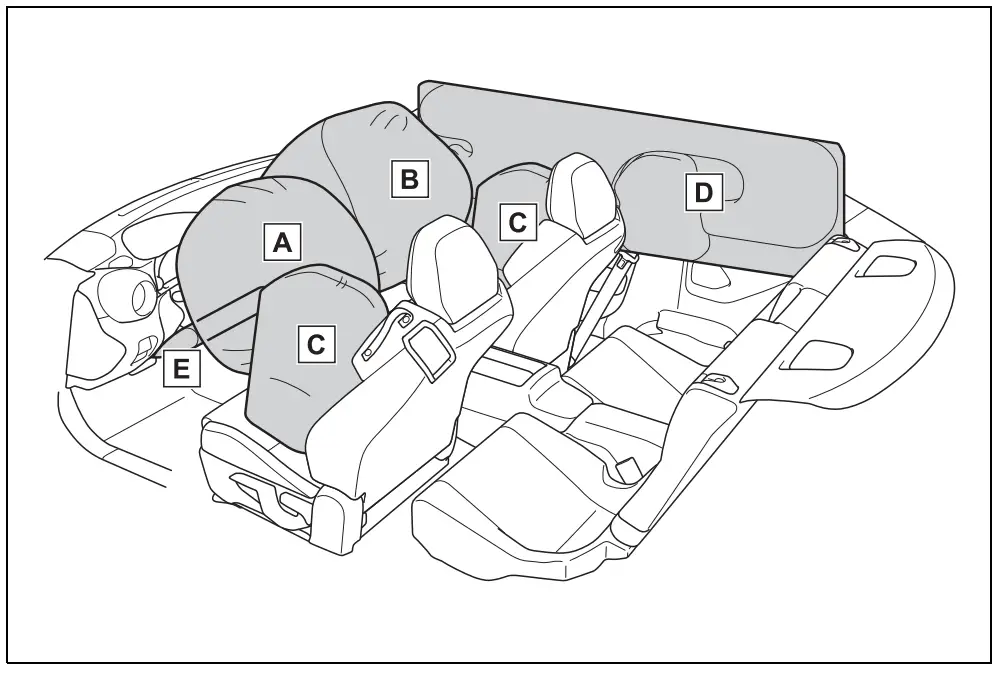
- Driver’s SRS frontal airbag: in the center portion of the steering wheel An “SRS AIRBAG” mark is located on the pad of the airbag.
- Front passenger’s SRS frontal airbag: near the top of the right side of the dashboard An “SRS AIRBAG” mark is located on the right corner of the dashboard.
- SRS side airbag: in the door side of each front seat seatback An “SRS AIRBAG” mark is located on the door side of each front seat cushion.
- SRS curtain shield airbag: in the roof side (between the front pillar and a point over the rear seat) “SRS AIRBAG” marks are located at the top of each center pillar.
- SRS knee airbag: under the steering column An “SRS AIRBAG” mark is located at the door of the airbag. A
SRS airbag system components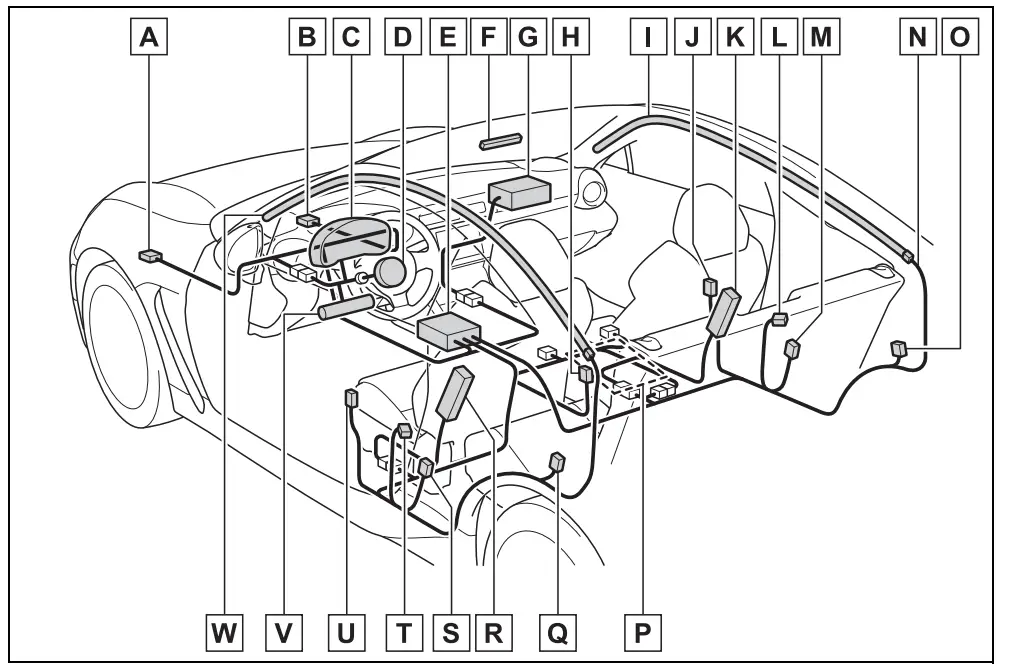
- Front impact sensor (left-hand side)
- Front impact sensor (right-hand side)
- SRS warning light
- Frontal airbag module (driver’s side)
- Airbag control module (including impact sensor and rollover sensor)
- Front passenger’s frontal airbag ON and OFF indicator
- Frontal airbag module (front passenger’s side)
- Seatbelt buckle switch (front passenger’s side)
- Curtain shield airbag module (right-hand side)
- Side impact sensor (door right-hand side)
- Side airbag module (front passenger’s side)
- Seatbelt pretensioner and adaptive force limiter (front passenger’s side)
- Side impact sensor (center pillar on right-hand side)
- Airbag wiring
- Side impact sensor (rear wheelhouse right-hand side)
- Front passenger’s occupant detection system sensor
- Side impact sensor (rear wheelhouse left-hand side)
- Side airbag module (driver’s side)
- Side impact sensor (center pillar left-hand side)
- Seatbelt pre tensioner (driver’s side)
- Side impact sensor (door left-hand side)
- Knee airbag module (driver’s side)
- Curtain shield airbag module (left-hand side)
If the SRS airbag deploys
If the SRS airbag deploys, fuel supply will be cut off to reduce the risk of fire caused by leaking fuel. For details about restarting of the engine, refer to (P347)
SRS Airbag System Servicing
In the following cases, contact your Toyota dealer as soon as possible.
- The front part of the vehicle was involved in an accident in which only the driver’s SRS frontal airbag or both driver’s and front passenger’s SRS frontal airbags did not deploy.
- The pad of the steering wheel, the cover over the front passenger’s SRS frontal airbag, or either roof side (from the front pillar to a point over the rear seat) is scratched, cracked, or otherwise damaged.
- The center pillar, door, rear-wheel house or rear subframe, or an area near these parts, was involved in an accident in which the SRS side airbag and SRS curtain shield airbag did not deploy.
- The fabric or leather of either front seatback is cut, frayed, or otherwise damaged.
- The rear part of the vehicle was involved in an accident in which no SRS airbag was deployed.
When you sell your vehicle
When you sell your vehicle, we urge you to inform the buyer that the vehicle is equipped with SRS airbags. Also, notify the buyer of the applicable section in this Owner’s Manual.
WARNING
General Precautions Regarding SRS Airbag System
- To obtain maximum protection in the event of an accident, the driver and all passengers must always wear seatbelts when in the vehicle. The SRS airbag is designed only to be a supplement to the primary protection provided by the seatbelt. It does not eliminate the need to fasten seatbelts. In combination with seatbelts, it offers the best protection in case of a serious accident.
Not wearing a seatbelt increases the chance of severe injury or death in a crash even when the vehicle has the SRS airbag.
For instructions and precautions concerning the seatbelt system - The SRS side airbags and SRS curtain shield airbags are designed only to be a supplement to the primary protection provided by the seatbelt. They do not eliminate the need to fasten seatbelts. It is also important to wear a seatbelt to help avoid injuries that can result when an occupant is not seated in a proper upright position.
- The SRS airbags deploy with considerable speed and force. Occupants who are not seated in proper upright positions when the SRS airbag deploys could suffer serious injury. Because the SRS airbag needs enough space for deployment, the driver should always sit upright and back in the seat as far from the steering wheel as practical while still maintaining full vehicle control, and the front passenger should move the seat as far back as possible and sit upright and well back in the seat.
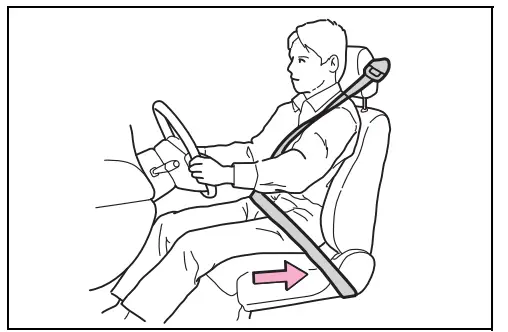
- Do not sit or lean close to either door. The SRS side airbags are stored in both front seat seat-backs next to the door, and they provide protection by deploying rapidly in the event of a side-impact collision. However, the force of SRS side airbag deployment can injure an occupant whose body is too close to an SRS airbag.
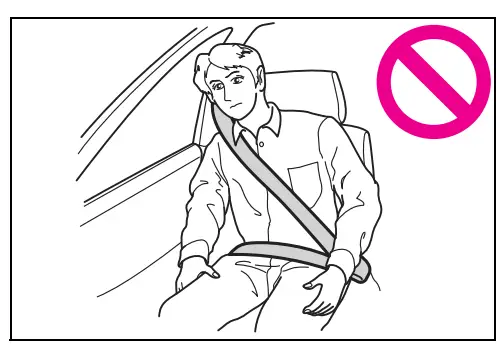
- Since your vehicle is equipped with SRS curtain shield airbags, do not sit or lean close to the door on either side. Do not put body parts out of the window. The SRS curtain shield airbags on both sides of the cabin are stored on the roof side (between the front pillar and a point behind the rear quarter glass), and they provide protection by deploying rapidly in the event of a side impact, rollover, or an off-set frontal collision. However, the force of its deployment can injure an occupant whose body is too close to an SRS airbag.
- Do not sit or lean unnecessarily close to the SRS airbag. Because the SRS airbag deploys with considerable speed and force to protect in high-speed collisions, the force of an airbag can injure an occupant whose body is too close to the SRS airbag.
It is also important to wear seatbelts to help avoid injuries that can result when the SRS airbag contacts an occupant not in their proper position.
Even when properly positioned, there remains a possibility that an occupant may suffer minor injuries, such as abrasions and bruises to the face or arms, because of the SR’s airbag deployment force. - Keep arms away from either the door or its internal trim. They could be injured in the event of SRS side airbag deployment.

- Do not place any objects over or near the SRS airbag cover or between you and the SRS airbag. If the SRS airbag deploys, these objects could interfere with its proper operation and could be propelled inside the vehicle, causing injury.
If the SRS airbag deploys
- When the SRS airbag deploys, some smoke will be released. This smoke could cause breathing problems for people with a history of asthma or other breathing trouble. If you or your passengers have breathing problems after the SRS airbag deploys, get fresh air promptly.
- A deploying SRS airbag releases hot gas. Occupants could get burned if they come into direct contact with the hot gas.
General Precautions regarding SRS Airbag System for Accessories and Any Objects
- Do not put any objects (including straps or cords) over the steering wheel pad, column cover, or dashboard.
- These objects could be entangled with the steering wheel, preventing the SRS frontal airbag, etc. from operating properly.
- If the SRS frontal airbag deploys, these objects could be propelled inside the vehicle, causing injury.
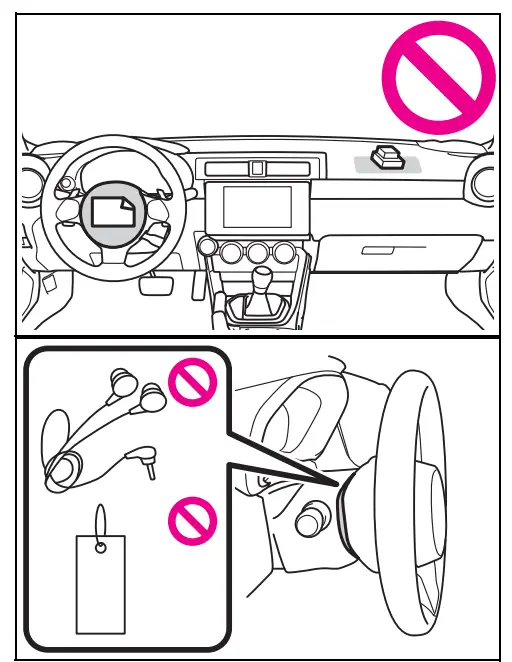
- Do not put any objects under the driver’s side of the instrument panel. If the SRS knee airbag deploys, those objects could interfere with its proper operation and could be propelled inside the vehicle, causing injury.
- Do not attach accessories to the windshield, or fit an extra-wide mirror over the inside rearview mirror. If the SRS airbag deploys, those objects could become projectiles that could seriously injure vehicle occupants.
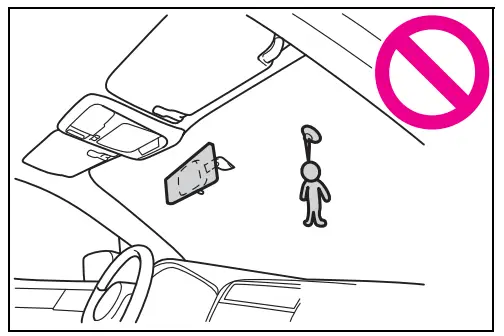
- Do not attach accessories to the door trim or near either SRS side airbags and do not place objects near the SRS side airbags. In the event of SRS side airbag deployment, they could be propelled dangerously toward the vehicle’s occupants and cause injuries.

- Do not attach a hands-free microphone or any other accessory to a front pillar, a center pillar, a rear pillar, the windshield, a side window, or any other cabin surface that would be near a deploying SRS curtain shield airbag. A hands-free microphone or another accessory in such a location could be propelled through the cabin with great force by the curtain shield airbag, or it could prevent the correct deployment of the curtain shield airbag. In either case, the result could be serious injuries.
- Do not put any kind of clothes or other objects over the front seatback and do not attach labels or stickers to the front seat surface on or near the SRS side airbag. They could prevent proper deployment of the SRS side airbag, reducing protection available to the front seat occupant.
- Do not install a seat cover unless it is a genuine Toyota seat cover exclusively designed for use with the SRS airbag. Even when using a genuine Toyota seat cover, the SRS side airbag system may not function normally if the seat cover is not installed correctly.

General Precautions regard-ing SRS Airbag System and Children
- Place children in the rear seat properly restrained at all times. The SRS airbag deploys with considerable speed and force and can injure or even kill children, especially if they are not restrained or improperly restrained. Because children are lighter and weaker than adults, their risk of being injured from deployment is greater. For that reason, we strongly recommend that ALL children (including those in child restraint systems) sit in the REAR seat properly restrained at all times in a child restraint device or in a seatbelt, whichever is appropriate for the child’s age, height, and weight.
Secure ALL types of child restraint systems (including forward facing child restraint systems) in the REAR seats at all times.
According to accident statistics, children are safer when properly restrained in the rear seating positions than in the front seating positions.
For instructions and precautions concerning the child restraint system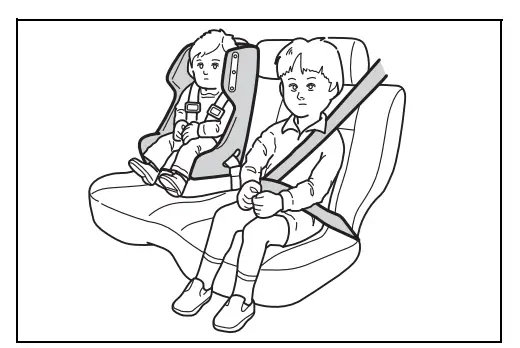
- NEVER INSTALL A CHILD RESTRAINT SYSTEM IN THE FRONT SEAT. DOING SO RISKS SERIOUS INJURY OR DEATH TO THE CHILD BY PLACING THE CHILD’S HEAD TOO CLOSE TO THE SRS AIRBAG.

- Never allow a child to stand up or kneel on the front passenger’s seat. The SRS airbag deploys with considerable force and can injure or even kill the child.
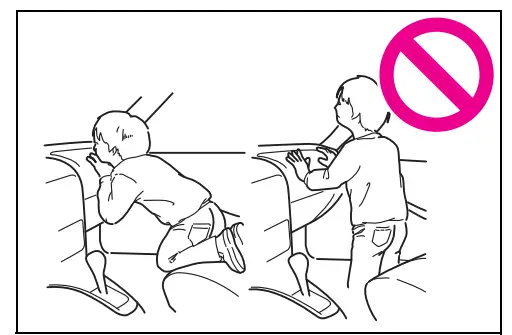
- Never hold a child on your lap or in your arms. The SRS airbag deploys with considerable force and can injure or even kill the child.
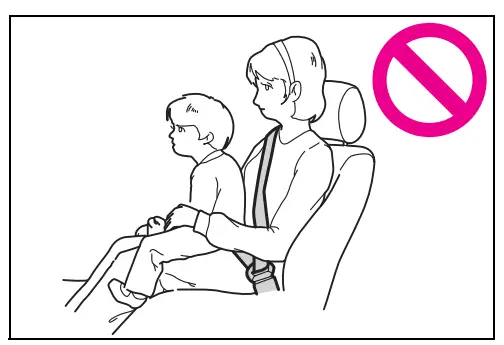
- Never allow a child to do the following.
- Kneel on any passenger’s seat facing the side window
- Wrap his/her arms around the front seat seatback
- Put his/her head, arms, or other parts of the body out of the window

In the event of an accident, the force of the SRS side airbag and/or SRS curtain shield airbag deployment could injure the child seriously because his/her head, arms or other parts of the body are too close to the SRS side airbag and/or SRS curtain shield airbag.
- Since your vehicle is also equipped with a front passenger’s SRS frontal airbag, children should be placed in the rear seat and should be properly restrained at all times.
- SRS Airbag System Servicing
- The SRS airbag has no user-serviceable parts. Do not use electrical test equipment on any circuit related to the SRS airbag system. For the required servicing of the SRS airbag, consult your nearest Toyota dealer. Tampering with or disconnecting the system’s wiring could result in accidental inflation of the SRS airbag or could make the system inoperative, which may result in serious injury.
- Precautions against Vehicle Modification
- To avoid accidental activation of the system or rendering the system inoperative, which may result in serious injury, no modifications should be made to any components or wiring of the SRS airbag system.
This includes the following modifications.- Installation of custom steering wheels
- Attachment of additional trim materials to the dashboard
- Installation of custom seats
- Replacement of seat fabric or leather
- Installation of additional fabric or leather on the front seat
- Attachment of a hands-free microphone or any other accessory to a front pillar, a center pillar, a rear pillar, the windshield, a side window, an assist grip, or any other cabin surface that would be near a deploying SRS curtain shield airbag.
- Installation of additional electrical/electronic equipment such as a mobile two-way radio on or near the SRS airbag system components and/or wiring is not advisable. This could interfere with the proper operation of the SRS airbag system.
- Modifications on or inside the door panels for the purpose of a speaker replacement or sound insulation
- The impact sensors, which detect the pressure of an impact, are located in the doors. Do not modify any components of the doors or door trims, such as the addition of door speakers for example. Any modifications to the doors will create a risk of the airbag system becoming inoperative or unintended air-bag deployment.
- Do not perform any of the following modifications. Such modifications can interfere with the proper operation of the SRS airbag system.
- Attachment of any equipment (bush bar, winches, snow plow, skid plate, etc.) other than genuine Toyota accessory parts to the front end.
- Modification of the suspension system or front-end structure.
- Installation of a tire of different sizes and construction from the tires specified on the vehicle placard attached to the driver’s center pillar or specified for individual vehicle models in this Owner’s Manual.
- Attachment of any equipment (side steps or side sill protectors, etc.) other than genuine Toyota accessory parts to the side body.
Always consult your Toyota dealer if you want to install any accessory parts on your vehicle.
NOTICE
- SRS Airbag System Servicing
- When discarding an airbag module or scrapping the entire vehicle damaged by a collision, consult your Toyota dealer.
- If you need service or repair in areas indicated in the following list, have the work performed by an authorized Toyota dealer. The SRS airbag control module, impact sensors, and airbag modules are stored in these areas.
- Under the center of the instrument panel
- On both the right and left sides at the front of the vehicle
- Steering wheel and column and nearby areas
- Bottom of the steering column and nearby areas
- Top of the dashboard on the front passenger’s side and nearby areas
- Each front seat and nearby area
- Inside each center pillar
- Inside each door
- On each roof side (from the front pillar to a point over the rear seat)
- Between the rear seat cushion and rear wheelhouse on each side
- In the event that the SRS airbag is deployed, replacement of the system should be performed only by an authorized Toyota dealer. When the components of the SRS airbag system are replaced, use only genuine Toyota parts.
Toyota Advanced Frontal Airbag System
This vehicle is equipped with Toyota’s advanced frontal airbag system that complies with the advanced frontal airbag requirements in the amended Federal Motor Vehicle Safety Standard (FMVSS) No. 208.
The Toyota advanced frontal air-bag system automatically determines the deployment force of the driver’s SRS frontal airbag at the time of deployment as well as whether or not to activate the front passenger’s SRS frontal airbag and, if activated, the deployment force of the SRS frontal airbag at the time of deployment.
Always wear your seatbelt. The Toyota advanced frontal airbag system is a supplemental restraint system and must be used in combination with a seatbelt. All occupants should wear a seatbelt or be seated in an appropriate child restraint system.
For the locations of the SRS airbags,
In a moderate to severe frontal collision, the following components deploy.
- SRS frontal airbag for the driver
- SRS frontal airbag for the front passenger
- SRS curtain shield airbag*
- SRS knee airbag for the driver
*: When an offset frontal collision that is severe enough to deploy the front airbag occurs.
These components supplement the seatbelts by reducing the impact on the occupant’s head, chest, and knees.
Driver’s SRS frontal airbag
The driver’s SRS frontal airbag uses a dual-stage inflator. The inflator operates in different ways depending on the severity of the impact.
Front passenger’s SRS frontal airbag
The front passenger’s SRS frontal airbag uses a dual-stage inflator. The inflator operates in different ways depending on the severity of the impact.
Occupant detection system
The occupant detection system sensors are installed between the seat and seat rails and monitor the physique and posture of the front passenger. Using this information, the occupant detection system determines whether the front passenger’s SRS frontal airbag should be deployed or not.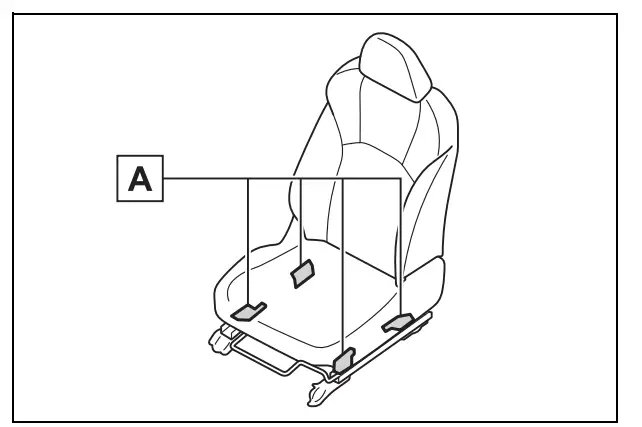
Occupant detection sensors
The occupant detection system may not inflate the front passenger’s SRS frontal airbag even when the driver’s SRS frontal airbag deploys. This is normal. In this case, although the front passenger’s SRS frontal airbag does not operate, the front passenger’s seatbelt pre-tensioner operates with the driver’s seatbelt pre-tensioner. For details about the seatbelt pretensioner,
Passenger’s frontal airbag ON and OFF indicators 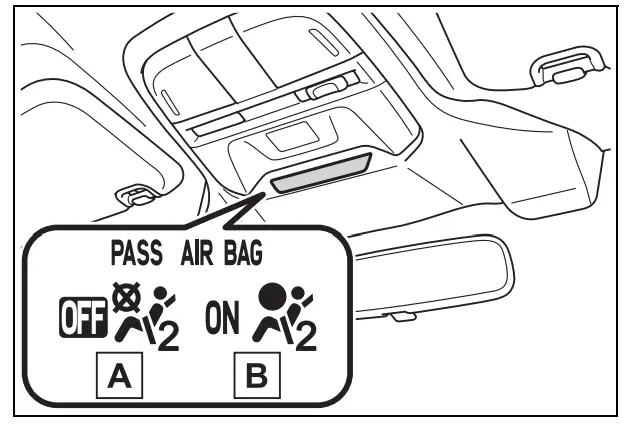
- Front passenger’s frontal air-bag OFF indicator
- Front passenger’s frontal airbag ON
Operation
Driver’s side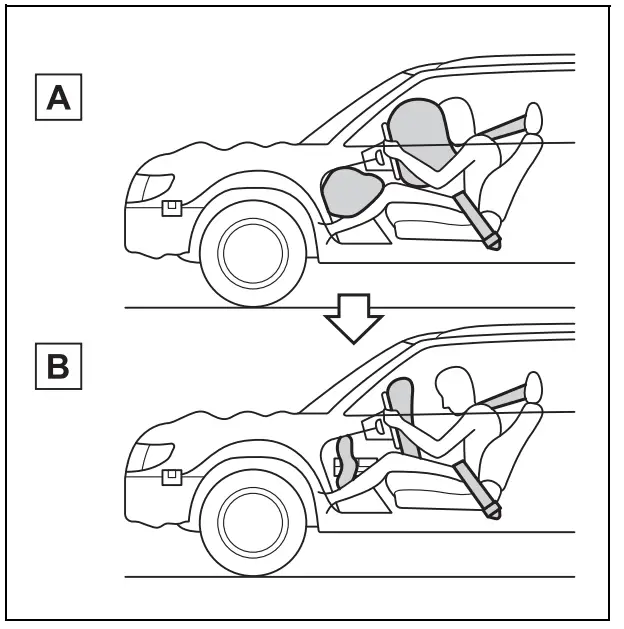
- SRS AIRBAGs deploy as soon as a collision occurs.
- After deployment, SRS AIR-BAGs start to deflate immediately so that the driver’s vision is not obstructed.
- Passenger’s side

- SRS AIRBAG deploys as soon as a collision occurs.
- After deployment, SRS AIR-BAG starts to deflate immediately so that the driver’s vision is not obstructed.
The SRS airbags can function only when the engine switch is in ON.
The Toyota advanced frontal airbag system is designed to determine the activation or deactivation condition of the front passenger’s SRS frontal airbag depending on the characteristic of item(s) or person on the front passenger’s seat monitored by the front passenger’s occupant detection system sensor. For this reason, only the driver’s SRS frontal airbag may deploy in the event of a collision, but this does not mean failure of the system.
If the following sensors detect a predetermined amount of force during a frontal collision, the control module sends signals to the airbag module(s) (only the driver’s module or both driver’s and front passenger’s modules) instructing the module(s) to inflate the SRS frontal airbag(s).
- The front impact sensors
- the impact sensors in the air-bag control module
On the driver’s side, the SRS knee airbag also inflates with the SRS frontal airbag.
The driver’s and front passenger’s SRS frontal airbags use dual-stage inflators. The two inflators of each airbag are triggered either sequentially or simultaneously, depending on the severity of impact, in the case of the driver’s SRS frontal airbag and depending on the severity of impact and the characteristic of item(s) or person on the seat in the case of the front passenger’s SRS frontal airbag.
After deployment
After deployment, the SRS airbag immediately starts to deflate so that the driver’s vision is not obstructed and the driver’s ability to maintain control of the vehicle is not impaired. The time required from detecting impact to the deflation of the SRS airbag after deployment is shorter than the blink of an eye.
Both when only the driver’s SRS frontal airbag deploys and the driver’s and front passenger’s SRS frontal airbags deploy, the driver’s and front passenger’s seatbelt pre-tensioners operate at the same time.
When the SRS airbag deploys, a sudden, fairly loud inflation noise will be heard and some smoke will be released. These occurrences are a normal result of the deployment. This smoke does not indicate a fire in the vehicle.
Example of the type of accident
The driver’s SRS frontal airbag and front passenger’s SRS frontal airbag are designed as follows.
- To deploy in the event of an accident involving a moderate to severe frontal collision
- To function on a one-time-only basis
The driver’s SRS frontal airbag and front passenger’s SRS frontal airbag are not designed as follows.
- To deploy in most lesser frontal impacts*1
- To deploy in most side or rear impacts or in most rollover accidents*2
*, 1:Because the necessary protection can be achieved by the seatbelt alone.
*2:Because deployment of only the driver’s SRS frontal airbag or both the driver’s and front passenger’s SRS frontal airbags would not protect the occupant in those situations.
SRS airbag deployment depends on the level of force experienced in the passenger compartment during a collision. That level differs from one type of collision to another, and it may have no bearing on the visible damage done to the vehicle itself. - Example of an accident in which the driver’s/driver’s and front passenger’s SRS frontal airbag(s) will most likely deploy
A head-on collision against a thick concrete wall at a vehicle speed of 12 to 19 mph (20 to 30 km/h) or higher activates only the driver’s SRS frontal airbag or both driver’s and front passenger’s SRS frontal airbags. The airbag(s) will also be activated when the vehicle is exposed to a frontal impact similar in fashion and magnitude to the collision described above.
- Examples of the types of accidents in which it is possible that the driver’s/driver’s and front passenger’s SRS frontal airbag(s) will deploy
Only the driver’s SRS frontal airbag or both driver’s and front passenger’s SRS frontal airbags may be activated when the vehicle sustains a hard impact in the undercarriage area from the road surface (such as when the vehicle plunges into a deep ditch, is severely impacted or knocked hard against an obstacle on the road such as a curb).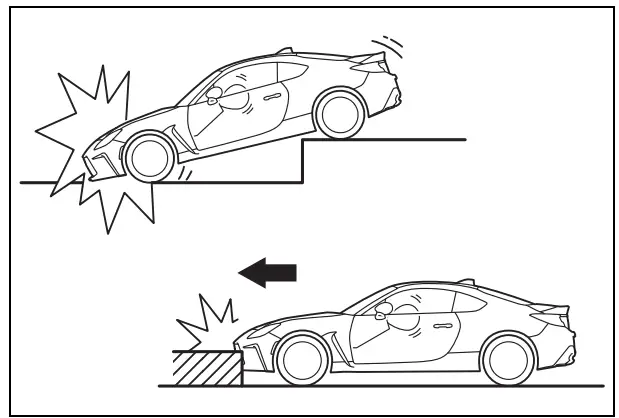
- Examples of the types of accidents in which deployment of the driver’s/driver’s and front passenger’s SRS frontal airbag(s) is unlikely to occur
There are many types of collisions that might not necessarily require the deployment of the driver’s/driver’s and front passenger’s SRS frontal airbag (s). In the event of accidents like those illustrated, the
driver’s/driver’s and front passenger’s SRS frontal airbag(s) may not deploy depending on the level of accident forces involved.- The vehicle strikes an object, such as a telephone pole or sign pole.
- The vehicle slides under the load bed of a truck.

- The vehicle sustains an oblique offset frontal impact.
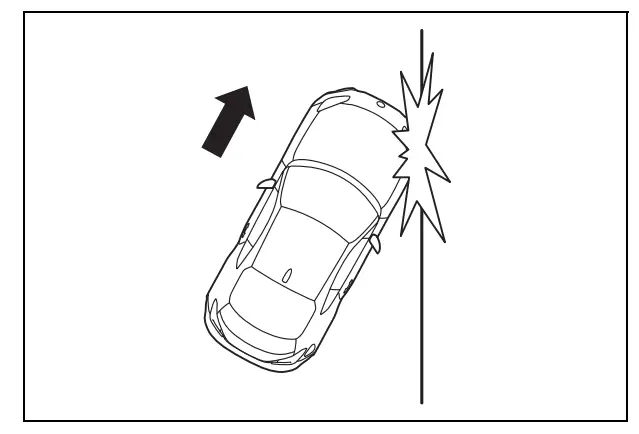
- The vehicle sustains an offset frontal collision.
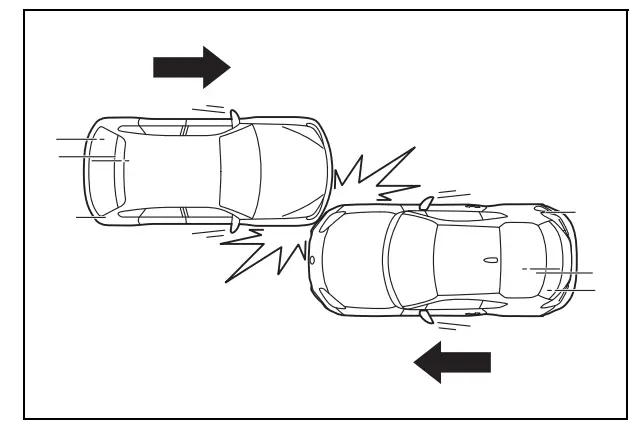
- The vehicle strikes an object that can move or deform, such as a parked vehicle.
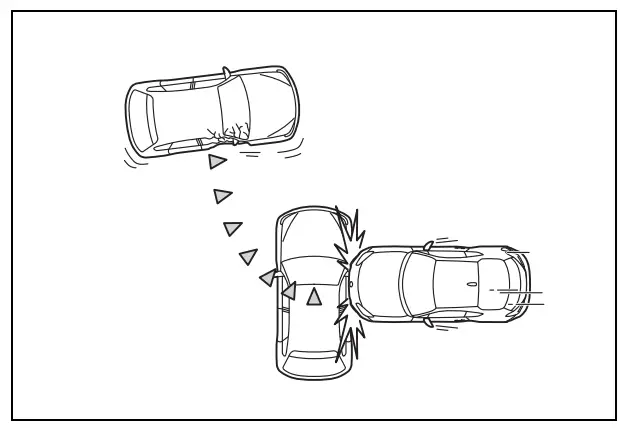
- If the vehicle is struck from the side or from behind

- If the vehicle rolls onto its side or roof
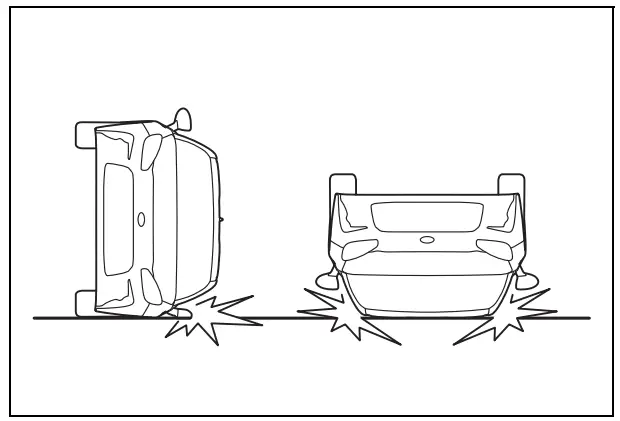
- If the vehicle is involved in a low-speed frontal collision

In an accident where the vehicle is impacted more than once, the driver’s and/or front passenger’s SRS frontal airbag(s) will deploy only once on the first impact of sufficient severity.
Example: In the case of a double collision, first with another vehicle, then against a concrete wall in immediate succession, once either or both of the driver’s and front passenger’s SRS frontal airbags is/are activated on the first impact, it/they will not be activated on the second impact.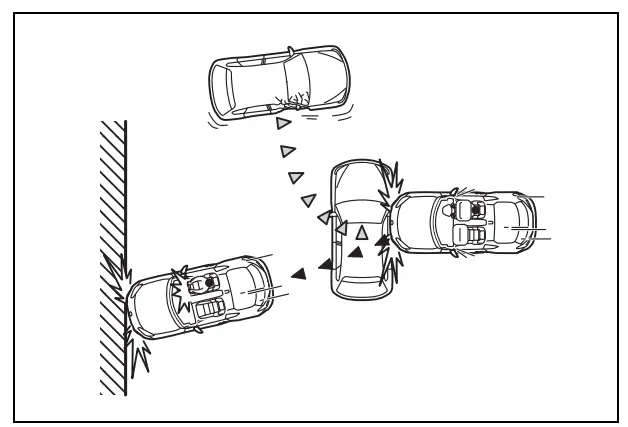
Warning labels and tag
This vehicle has warning labels on the driver’s and front passenger’s sun visors beginning with the phrase “EVEN WITH ADVANCED AIR BAGS” and a tag attached to the glove box lid beginning with the phrase “Even with Advanced Air Bags”. Make sure that you carefully read the instructions on the warning labels and tag.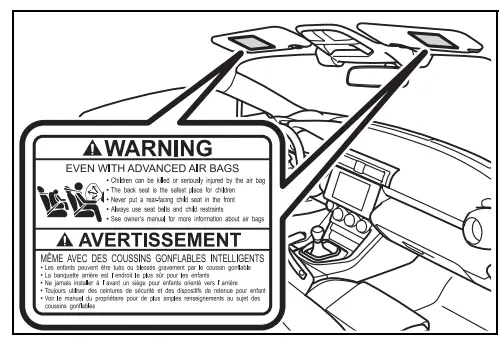
Toyota’s advanced frontal airbag system
- The SRS side airbag and seatbelt pre-tensioner are not controlled by the Toyota advanced frontal airbag system.
- The front passenger’s SRS side airbag and SRS curtain shield airbag are not controlled by the Toyota advanced frontal airbag system
Conditions in which the front passenger’s SRS frontal airbag is not activated
The front passenger’s SRS frontal airbag will not be activated when any of the following conditions are met regarding the front passenger’s seat:
- The seat is empty.
- The seat is equipped with an appropriate child restraint system and an infant or a child is restrained in it. (See the WARNING that follows.)
- the front passenger’s occupant detection system is malfunctioning.
Conditions in which the front passenger’s SRS frontal airbag is activated
The front passenger’s SRS frontal airbag will be activated for deployment upon impact when any of the following conditions are met regarding the front passenger’s seat.
- When the seat is occupied by an adult.
- When certain items (e.g. jug of water) are placed on the seat.
If the front passenger’s frontal airbag ON indicator illuminates and the OFF indicator turns off
If you think that the Front passenger’s frontal airbag ON/OFF indicator is incorrect, take the following actions.
- Ensure that no article is placed on the seat other than the occupant.
- Ensure that the backward-forward position and seatback of the front passenger’s seat are locked into place securely by moving the seat back and forth.
If the ON indicator still remains illuminated while the OFF indicator turns off after taking the relevant corrective actions described above, immediately contact your Toyota dealer for an inspection.
Even if the system has passed the dealer inspection, it is recommended that on subsequent trips the small adult always takes the rear seat.
If the passenger’s frontal airbag OFF indicator illuminates and the ON indicator turns off even when the front passenger’s seat is occupied by an adult
This can be caused by the adult incorrectly sitting in the front passenger’s seat.
- Turn the engine switch off.
- Ask the front passenger to set the seatback to the upright position, sit up straight in the center of the seat cushion, correctly fas-ten the seatbelt, position his/her legs out forward, and adjust the seat to the rearmost position.
- Turn the engine switch to ON.
If the OFF indicator remains illuminated while the ON indicator remains off, take the following actions.- Turn the engine switch off.
- Make sure that the front passenger does not use a blanket, extra seat cushion, seat cover, extra seat heater or massager, etc.
- If wearing excessive layers of clothing, the front passenger should remove any unnecessary items before sitting in the front passenger’s seat, or should sit in a rear seat.
- Turn the engine switch to ON and wait 6 seconds to allow the system to complete self-check-ing. Following the system check, both indicators turn off for 2 seconds. Now, the ON indicator should illuminate while the OFF indicator remains off.
If the OFF indicator still remains illuminated while the ON indicator remains off, ask the occupant to move to the rear seat and immediately contact your Toyota dealer for an inspection.
If the seatbelt buckle switch and/or front passenger’s occupant detection system has failed
If the seatbelt buckle switch and/or front passenger’s occupant detection system has failed, the SRS warning light will illuminate. Have the system inspected by your Toyota dealer immediately if the SRS warning light illuminates.
When to contact your Toyota dealer
If your vehicle has sustained impact, this may affect the proper function of the Toyota advanced frontal airbag system. Has your vehicle been inspected at your Toyota dealer? Do not use the front passenger’s seat while driving the vehicle to your Toyota dealer.
WARNING
When using a child restraint system
NEVER INSTALL A CHILD RESTRAINT SYSTEM IN THE FRONT PASSENGER’S SEAT EVEN IF THE FRONT PASSENGER’S SRS FRONTAL AIRBAG IS DEACTIVATED. Be sure to install it in the REAR seat in the correct manner. Also, it is strongly recommended that any forward-facing child seat or booster seat be installed in the REAR seat and that even children who have outgrown a child restraint system be also seated in the REAR seat. This is because children sitting in the front passenger’s seat may be killed or severely injured should the front passenger’s SRS frontal airbag deploy. REAR seats are the safest place for children.
General Precautions regarding front passenger’s SRS frontal airbag
When the front passenger’s seat is occupied by an adult, observe the following precautions. Failure to do so may lessen the load on the front passenger’s seat, deactivating the front passenger’s SRS frontal airbag despite the fact that the seat is occupied by an adult. This may result in personal injury.
- Do not allow the rear seat occupant to lift the front passenger’s seat cushion using his/her feet.
- Do not place any article under the front passenger’s seat, or squeeze any article from behind and under the seat.
- Do not squeeze any article between the front passenger’s seat and the side trim/pillar, door, or center console box. This may lift the seat cushion.
When a small adult is seated in the front passenger’s seat
When a small adult is seated in the front passenger’s seat, the Toyota advanced frontal airbag system may or may not activate the front passenger’s SRS frontal airbag depending on the occupant’s seating posture. If the OFF indicator remains illuminated while the ON indicator turns off when a small adult is seated in the front passenger’s seat, refer to P.45.
- General Precautions regarding occupant detection system
Do not kick the front passenger seat or subject it to severe impact. Otherwise, the SRS warning light may illuminate to indicate a malfunction of the front passenger occupant detection system. In this case, contact your Toyota dealer immediately. - After deployment
Do not touch the SRS airbag system components around the steering wheel and dashboard with bare hands right after deployment. Doing so can cause burns because the components can be very hot as a result of deployment.
NOTICE
Toyota advanced frontal air-bag system precautions
Observe the following precautions. Failure to do so may prevent the Toyota advanced frontal airbag system from functioning correctly or cause the system to fail.
- Do not apply any strong impact to the front passenger’s seat such as by kicking.
- Do not let rear passengers rest their feet between the front seatback and seat cushion.
- Do not spill liquid on the front passenger seat. If the liquid is spilled, wipe it off immediately.
- Do not remove or disassemble the front passenger seat.
- Do not install any accessory (such as an audio amplifier) other than a genuine Toyota accessory under the front passenger’s seat.
- Do not place anything (shoes, umbrella, etc.) under the front passenger’s seat.
- Do not place any objects (books, etc.) around the front passenger’s seat.
- Do not use the front passenger’s seat with the head restraint removed.
- Do not leave any articles on the front passenger’s seat or the seatbelt tongue and buckle engaged when you leave your vehicle.
- Do not put a sharp object(s) on the seat or pierce the seat upholstery.
- Do not place a magnet near the seatbelt buckle and the seatbelt retractor.
- Do not use front seats with their backward-forward position adjuster and seatback adjuster not being locked into place securely. If any of them are not locked securely, adjust them again. For adjusting the procedure
When using the front passenger’s seat
Observe the following precautions as they increase the load on the front passenger’s seat and do not work properly.
- Do not install any accessory such as a table or TV onto the seatback.
- Do not allow the rear seat occupant to place his/her hands or legs on the front passenger’s seatback, or allow him/her to pull the seatback.
SRS side airbag and SRS curtain shield airbag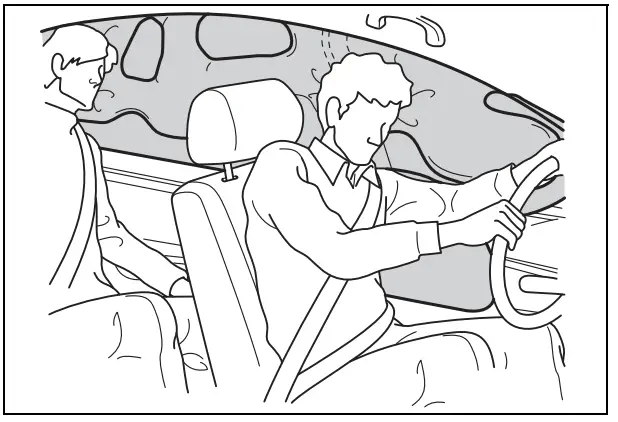
SRS side airbag
The SRS side airbag is stored in the door side of each front seat seatback, which bears an “SRS AIRBAG” mark. In a moderate to severe side impact collision, the SRS side airbag on the impacted side of the vehicle deploys between the occupant and the door panel and supplements the seatbelt by reducing the impact on the occupant’s chest and waist. The SRS side airbag operates only for front seat occupants.
SRS curtain shield airbag
- Your vehicle is equipped with an SRS curtain shield airbag system that complies with the Federal Motor Vehicle Safety Standard (FMVSS) No. 226.
- The SRS curtain shield airbag on each side of the cabin is stored on the roof side (between the front pillar and a point over the rear seat). An “SRS AIR-BAG” mark is located at the top of each center pillar.
- In a moderate to severe side impact collision, the SRS curtain shield airbag on the impacted side of the vehicle deploys between the occupant and the side window and supplements the seatbelt by reducing the impact on the occupant’s head.
- In a rollover, SRS curtain shield airbags on both sides of the vehicle deploy between the occupant and the side window and supplement the seatbelt by reducing the impact to the occupant’s head. In an offset frontal collision, SRS curtain shield airbags on both sides of the vehicle deploy between the occupant and the side window and supplement the seatbelt by reducing the impact to the occupant’s head and chest.
Operation
The SRS side airbag and SRS curtain shield airbag can function only when the engine switch is in ON. The following airbags deploy independently of each other since each has its own impact sensor.
- Driver’s SRS side airbag
- Front passenger’s SRS side airbag
- SRS curtain shield airbag (right-hand side)
- SRS curtain shield airbag (left-hand side)
Therefore, they may not both deploy in the same accident. Also, the SRS side airbag and SRS curtain shield airbag deploy independently of the driver’s and front passenger’s SRS frontal airbags in the steering wheel and instrument panel. For the locations of the sensors and control modules
After deployment
- After the deployment, the SRS side airbag immediately starts to deflate.
- The time required from detection of an impact to deflation of an SRS side airbag after deployment is shorter than the blink of an eye.
- The SRS curtain shield airbag remains inflated for a while following deployment then slowly deflates.
- The SRS side airbag and SRS curtain shield airbag deploy even when no one occupies the seat on the side on which an impact is applied.
- When the SRS side airbag and SRS curtain shield airbag deploy, a sudden, fairly loud inflation noise will be heard and some smoke will be released.
- These occurrences are a normal result of the deployment. This smoke does not indicate a fire in the vehicle.
Example of the type of accident
The SRS side airbag and SRS curtain shield airbag are designed as follows:
- To deploy in the event of an accident involving a moderate to severe side impact collision
- To function on a one-time-only basis.
The SRS side airbag and SRS curtain shield airbag are not designed to deploy in the following cases:
- In the lesser side impact
- In most frontal or most rear impacts (because the SRS side airbag and SRS curtain shield airbag deployment would not protect the occupant in those situations)
The SRS curtain shield airbags are also designed to deploy when the vehicle is in an extremely inclined state such as during a rollover. They are not designed to deploy in most lesser inclined states. SRS side airbag and SRS curtain shield airbag deployment depends on the level of force experienced in the passenger compartment during a side impact collision. That level dif-fers from one type of collision to another, and it may have no bearing on the visible damage done to the vehicle itself.
- Example of the type of accident in which the SRS side airbag will most likely deploy.
- A severe side impact near the front seat.

- Examples of the types of accidents in which the SRS curtain shield airbag will most likely deploy.
- The vehicle is involved in a severe side impact near the front seat or the rear seat.

- The vehicle rolls onto its side or the roof.
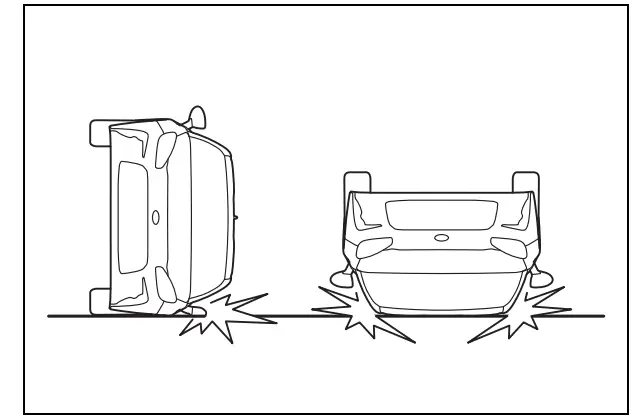
- The angle of vehicle tip-up is marginal or the skidding vehicle’s tires hit a curbstone laterally.
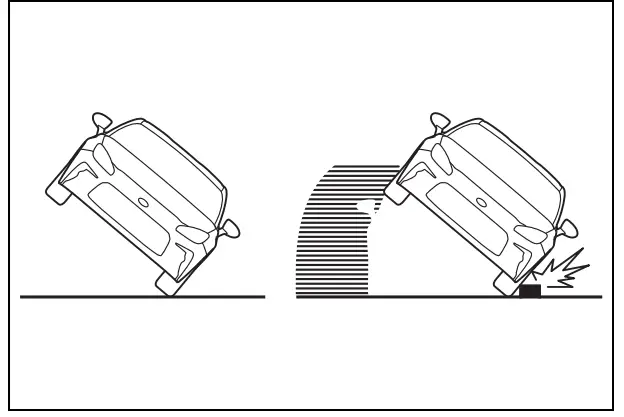
- An offset frontal collision that is severe enough to deploy the front airbag.
- The vehicle is involved in a severe side impact near the front seat or the rear seat.
Examples of the types of accidents in which it is possible that the SRS side airbag and the SRS curtain shield airbag will deploy. It is possible that the SRS side and curtain shield airbags will deploy if a serious impact occurs to the underside of your vehicle. Some examples are shown in the illustration.
Hitting a curb, edge of pavement or hard surface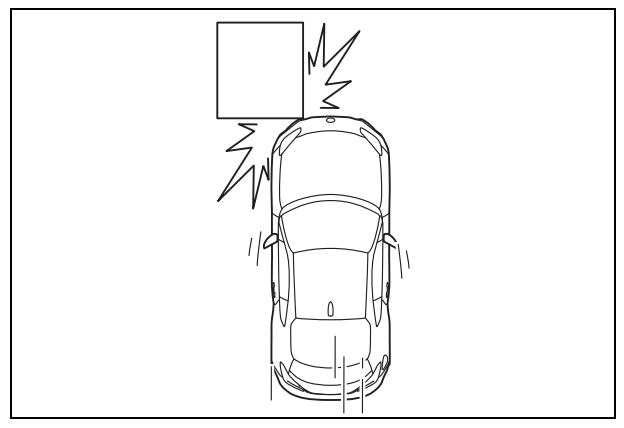
-
- Falling into or jumping over a deep hole

- Falling into or jumping over a deep hole

- Landing hard or vehicle falling
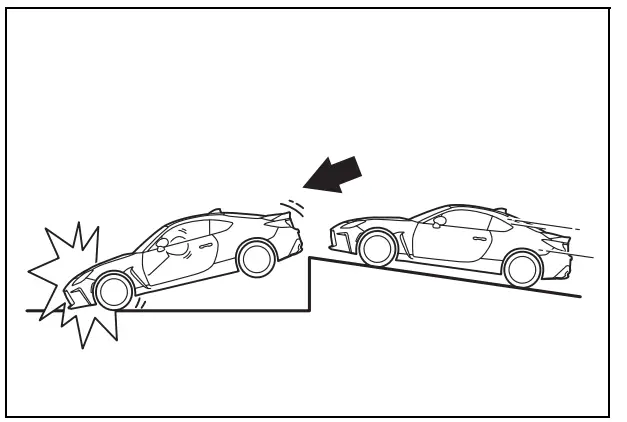
- Falling into or jumping over a deep hole
- Examples of the types of accidents in which the SRS side airbag is unlikely to deploy.
There are many types of collisions that might not necessarily require SRS side airbag deployment. In the event of accidents like those illustrated, the SRS side airbag may not deploy depending on the level of accident forces involved.- The vehicle is involved in an oblique side-on impact.

- The vehicle is involved in a side-on impact in an area outside the vicinity of the passenger compartment.
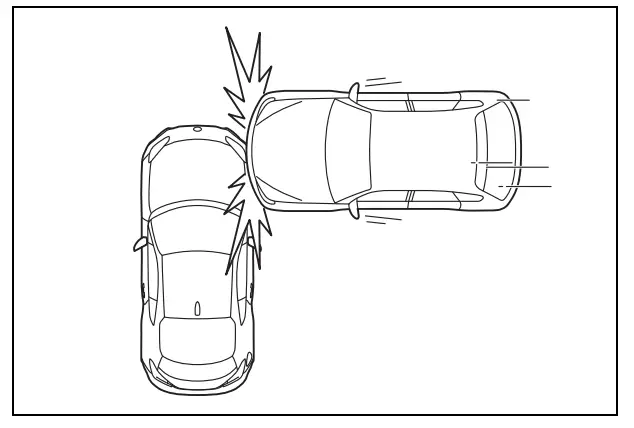
- The vehicle strikes a telephone pole or similar object.
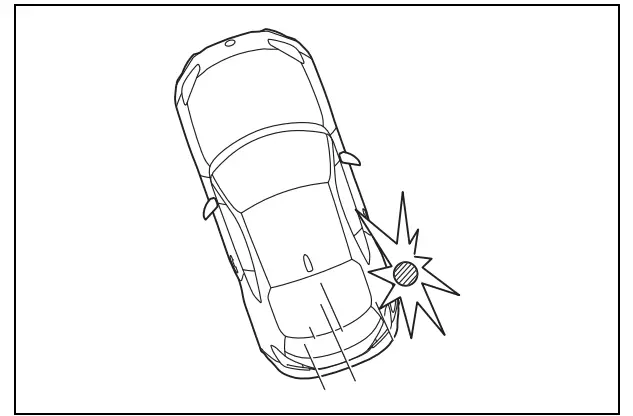
- The vehicle is involved in a side-on impact with a motorcycle.
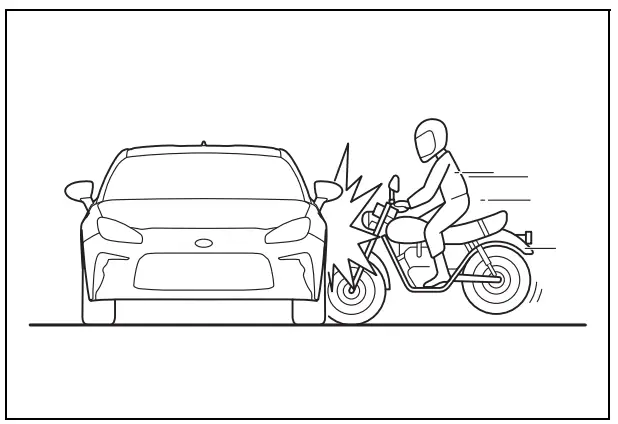
- The vehicle rolls onto its side or the roof.
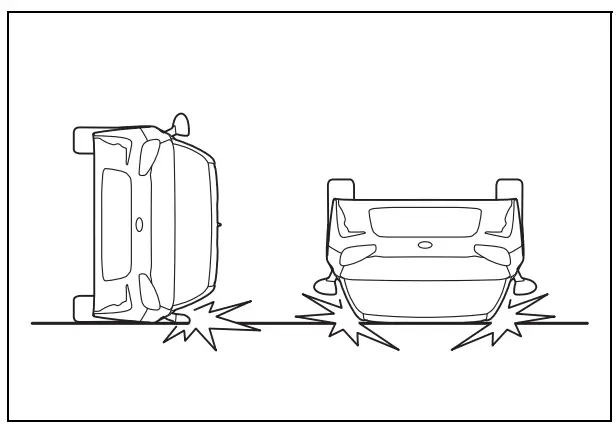
- The vehicle is involved in an oblique side-on impact.
- Examples of the types of accidents in which the SRS curtain shield airbag is unlikely to deploy.
There are many types of collisions that might not necessarily require SRS curtain shield airbag deployment. In the event of accidents like those illustrated, the SRS curtain shield airbag may not deploy depending on the level of accident forces involved.- The vehicle is involved in an oblique side-on impact.
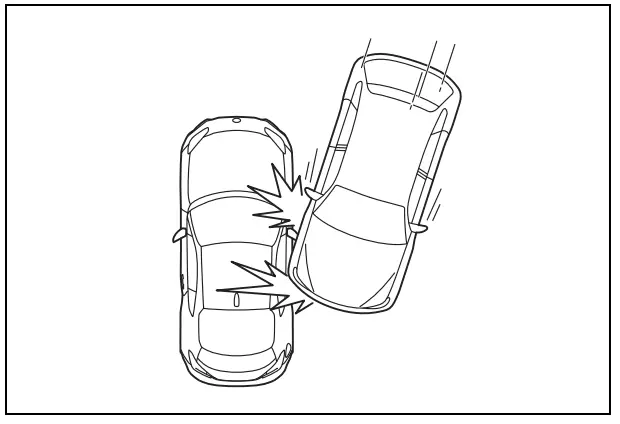
- The vehicle is involved in a side-on impact in an area outside the vicinity of the passenger compartment.
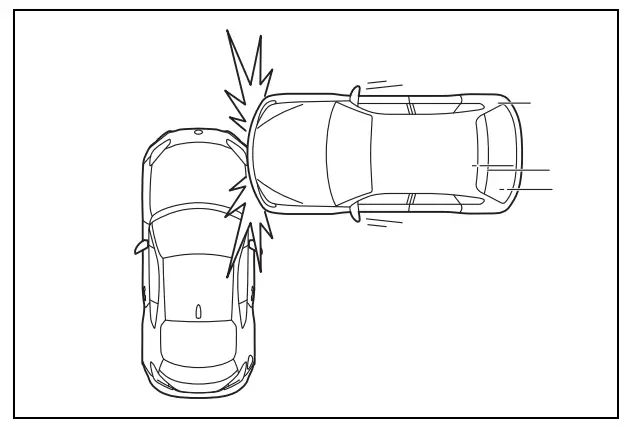
- The vehicle strikes a telephone pole or similar object.
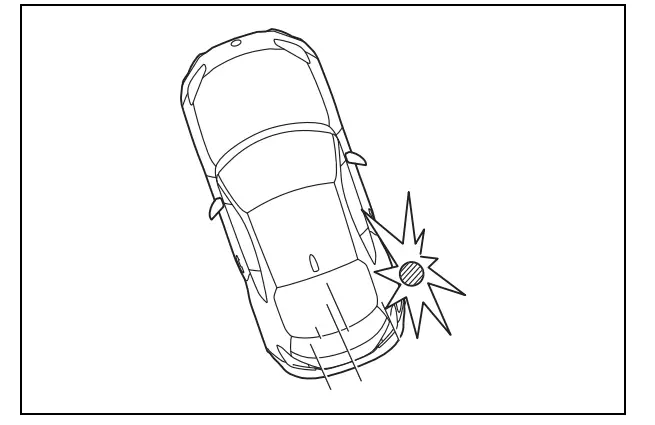
- The vehicle is involved in a side-on impact from a motorcycle.

- The vehicle is involved in an oblique side-on impact.
- Examples of the types of accidents in which the SRS side airbag and SRS curtain shield airbag are not designed to deploy in most cases In the event of accidents like those illustrated, the SRS side airbag and SRS curtain shield airbag are not designed to deploy in most cases.
- The vehicle is involved in a frontal collision with another vehicle (moving or stationary).

- The vehicle is struck from behind.
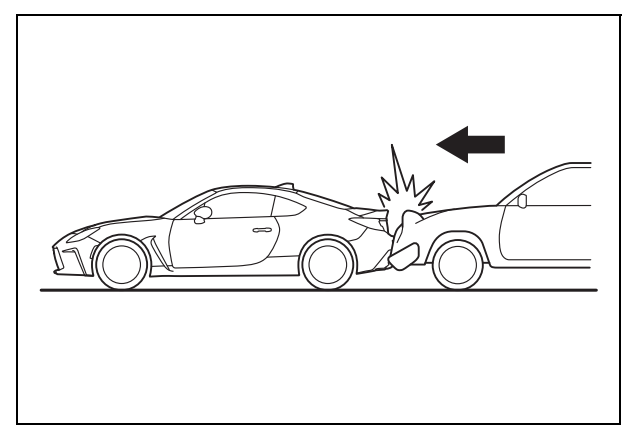
- The vehicle pitches end over end.

In an accident where the vehicle is struck from the side more than once, the SRS side airbag and SRS curtain shield airbag deploy only once on the first impact.
Example: In the case of a double side impact collision, first with one vehicle and immediately followed by another from the same direction, once the SRS side airbag and SRS curtain shield airbag are activated on the first impact, they will not be activated on the second.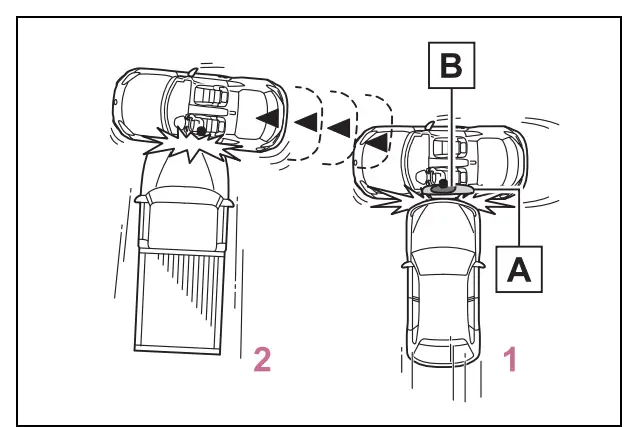
- SRS curtain shield airbag
- SRS side airbag
- First Impact
- Second impact
- The vehicle is involved in a frontal collision with another vehicle (moving or stationary).
WARNING
After deployment
- Do not touch the SRS side air-bag system components around the front seat seatback with bare hands right after deploy-ment. Doing so can cause burns because the components can be very hot as a result of deployment.
- After deployment, do not touch any part of the SRS curtain shield airbag system (from the front pillar to the part of the roof side over the rear seat). Doing so can cause burns because the components can be very hot as a result of deployment.
SRS Airbag System Monitors
A diagnostic system continually monitors the readiness of the SRS airbag system (including seatbelt pretensioners) with the engine switch is in ON. The SRS warning light will show nor-mal system operation by illuminating for approximately 6 seconds when the engine switch is turned to ON.
The following components are monitored by the indicator:
- Front impact sensor
- Right-hand side
Left-hand side
- Right-hand side
- Airbag control module (including impact sensor and rollover sensor)
- Frontal airbag module
- Driver’s side
- Front passenger’s side
- Knee airbag module
- Driver’s side
- Side impact sensor
- Center pillar left-hand side
- Center pillar right-hand side
- Forward of rear wheel house left-hand side
- Forward of rear wheel house right-hand side
- Door left-hand side
- Door right-hand side
- Side airbag module
- Driver’s side
- Front passenger’s side
- Curtain shield airbag module
- Right-hand side
- Left-hand side
- Seatbelt pretensioner
- Driver’s side
- Seatbelt pretensioner and adaptive force limiter
- Front passenger’s side
- Seatbelt buckle switch
- Front passenger’s side
- Front passenger occupant detection system sensors
- Front passenger’s frontal airbag ON and OFF indicator
- All related wiring
SRS warning light
Have the system inspected by your Toyota dealer immediately if the SRS warning light illuminates.
WARNING
SRS warning light
If the warning light exhibits any of the following conditions, immediately stop the vehicle in a safe place, and consult a Toyota dealer. Unless a technician checks and repairs the system as needed, the seatbelt pre-tensioners and/or the SRS airbag may not operate properly in the event of a collision, which may result in injury.
- Flashing or flickering of the warning light
- No illumination of the warning light when the engine switch is first turned to ON
- Continuous illumination of the warning light
- Illumination of the warning light while driving
Front passenger occupant classification system
Your vehicle is equipped with a front passenger occupant classification system. This system detects the conditions of the front passenger seat and activates or deactivates the front passenger airbag.
System components
The front passenger’s frontal airbag ON and OFF indicators show you the status of the front passenger’s SRS frontal airbag. When the engine switch is turned to ON, both the ON and OFF indicators illuminate while the system is checked, after which both indicators turn off.
After that, one of the indicators illuminates depending on the status of the front passenger’s SRS frontal airbag determined by the Toyota advanced frontal airbag monitoring system.
- SRS warning light
- Front passenger’s seat belt reminder light
- “AIR BAG OFF” indicator light
- “AIR BAG ON” indicator light
WARNING
Front passenger occupant classification system precautions
Observe the following precautions regarding the front passenger occupant classification system. Failure to do so may cause the occupant classification system to not function correctly, resulting in death or serious injury.
- Wear the seat belt properly.
- Do not apply excessive force to the seat.
- Do not put a sharp object(s) on the seat or pierce the seat upholstery.
- Do not put objects under the front passenger seat.
- Do not use a seat accessory, such as a cushion or seat cover, that covers the seat cushion surface.
- Do not spill liquid on the front passenger seat. If the liquid is spilled, wipe it off immediately and dry the seat. If the SRS warning light illuminates, dry the seat until the warning light turns off. If the SRS warning light stays on even when the seat has dried, do not allow anyone to sit on the front passenger seat and have the system checked by your Toyota dealer. If the SRS warning light does not illuminate, check that the airbag ON/OFF indicator light works properly. If the indicator light does not work properly, do not allow anyone to sit in the front passenger’s seat and have the system inspected by your Toyota dealer.
-
Do not remove or disassemble the front passenger seat. Also, do not replace or modify the seat upholstery or foam inside the seat.
-
Do not install any accessory (such as an audio amplifier) other than a genuine Toyota accessory under the front passenger’s seat.
-
Do not place magnetized items near the seat belt buckle.
-
Never install a rearward-facing child seat in the front passenger’s seat even if the front passenger’s SRS frontal airbag is deactivated. Be sure to install it in the rear seat in the correct manner. Also, it is strongly recommended that any forward-facing child seat or booster seat be installed in the rear seat, and that even children who have outgrown a child restraint system be also seated in the rear seat. This is because children sitting in the front passenger’s seat may be killed or severely injured should the front passenger’s SRS frontal airbag deploy. Toyota believes that the rear seats are the safest place for children.
-
If luggage or electronic devices are placed on the front passenger seat, the OFF indicator may turn off and the ON indicator may illuminate. If this occurs, the front passenger’s airbag may deploy during a collision. If this is not desirable, remove the luggage or electronic devices from the front passenger seat.
WARNING - Modifications for persons with disabilities that may affect the front passenger occupant classification system. (the U.S. only) Removing, replacing or modifying any parts of the front seats, seat belts, front bumper, front side frame, instrument panel, meter, steering wheel, steering column, tires, suspension, or floor panel can affect the operation of the Toyota front passenger occupant classification system.
Condition and operation in the front passenger occupant classification system*1
Adult*2
|
Indicator/warning light |
“AIR BAG ON” and “AIR BAG
OFF” indicator lights |
“AIR BAG ON” |
| SRS warning light | Off | |
| Front passenger’s seat belt reminder light | Flashing*3 | |
|
Devices |
Front passenger airbag |
On |
| Front side airbag*4 | ||
| Front curtain shield airbag*4 | ||
| Front passenger’s seat belt preten- sioner*4 |
Child*5, *6
|
Indicator/warning light |
“AIR BAG ON” and “AIR BAG
OFF” indicator lights |
“AIR BAG OFF”*5 |
| SRS warning light | Off | |
| Front passenger’s seat belt reminder light | Flashing*3 |
|
Devices |
Front passenger airbag | Off |
| Front side airbag*4 |
On |
|
| Front curtain shield airbag*4 | ||
| Front passenger’s seat belt preten- sioner*4 |
Child restraint system with infant*6, *7, *8
|
Indicator/warning light |
“AIR BAG ON” and “AIR BAG
OFF” indicator lights |
“AIR BAG OFF”*9 |
| SRS warning light |
Off |
|
| Front passenger’s seat belt reminder light | ||
|
Devices |
Front passenger airbag | Off |
| Front side airbag*4 |
On |
|
| Front curtain shield airbag*4 | ||
| Front passenger’s seat belt pretense- sioner*4 |
Unoccupied
|
Indicator/warning light |
“AIR BAG ON” and “AIR BAG
OFF” indicator lights |
“AIR BAG OFF” |
| SRS warning light |
Off |
|
| Front passenger’s seat belt reminder light | ||
|
Devices |
Front passenger airbag | Off |
| Front side airbag*4 |
On |
|
| Front curtain shield airbag*4 | ||
| Front passenger’s seat belt pretense- sioner*4 |
There is a malfunction in the system
|
Indicator/warning light |
“AIR BAG ON” and “AIR BAG
OFF” indicator lights |
“AIR BAG OFF” |
| SRS warning light | On | |
| Front passenger’s seat belt reminder light | Off | |
|
Devices |
Front passenger airbag | Off |
| Front side airbag*4 |
On |
|
| Front curtain shield airbag*4 | ||
| Front passenger’s seat belt pretense- sioner*4 |
- The occupant classification system does not operate during self-check-ing.
- The system judges a person of adult size as an adult. When a smaller adult sits in the front passenger seat, the system may not recognize him/her as an adult depending on his/her physique and posture.
- In the event, the front passenger does not wear a seat belt.
- The front passenger’s SRS side airbag, SRS curtain shield airbag, and seat belt pretensioner are not controlled by the occupant classification system.
- For some children, a child in a seat, a child in a booster seat, or a child in a convertible seat, the system may not recognize him/her as a child. Factors that may affect this can be physique or posture.
Children who have outgrown a child restraint system should always wear the seat belt when sitting in the seat irrespective of whether the airbag is deactivated or activated. - do not place more than one child on the front passenger seat. Failure to do so may prevent the front passenger occupant classification system from functioning correctly.
- when a child restraint system is installed on the front passenger seat, do not place any article on the seat other than the child occupant and a child restraint system.
Failure to do so may prevent the front passenger occupant classification system from functioning correctly or cause the system to fail. - Never install a rear-facing child restraint system on the front passenger seat. See the caution that follows regarding the installation of a child restraint system.
- In case the indicator is not illuminated, consult this manual on how to install the child restraint system properly.
Exhaust gas precautions
The harmful substance to the human body is included in exhaust gases if inhaled.
WARNING
Exhaust gases include harmful carbon monoxide (CO), which is colorless and odorless. Observe the following precautions. Failure to do so may cause exhaust gases to enter the vehicle and may lead to an accident caused by light-headedness, or may lead to death or a serious health hazard.
Important points while driving
- Keep the trunk lid closed.
- If you smell exhaust gases in the vehicle even when the trunk lid is closed, open the windows and have the vehicle inspected at your Toyota dealer as soon as possible.
- When parking
- If the vehicle is in a poorly ventilated area or a closed area, such as a garage, stop the engine.
- Do not leave the vehicle with the engine on for a long time. If such a situation cannot be avoided, park the vehicle in an open space and ensure that exhaust fumes do not enter the vehicle’s interior.
- Do not leave the engine running in an area with snow build-up, or where it is snowing. If snow-banks build up around the vehicle while the engine is running, exhaust gases may collect and enter the vehicle.
- Exhaust pipe
The exhaust system needs to be checked periodically. If there is a hole or crack caused by corrosion, damage to a joint, or abnormal exhaust noise, be sure to have the vehicle inspected and repaired by your Toyota dealer.
FAQ
A: The 2023 Toyota 86 typically comes equipped with standard safety features like a comprehensive airbag system, stability control, and anti-lock brakes.
A: Some trims of the 2023 Toyota 86 may offer advanced driver-assistance systems such as adaptive cruise control, lane departure warning, and automatic emergency braking.
A: Adaptive cruise control adjusts the vehicle’s speed based on the traffic flow, while lane departure warning alerts the driver when the vehicle unintentionally drifts out of its lane.
A: The availability of blind-spot monitoring and rear cross-traffic alert may vary depending on the trim and options.
A: Yes, the 2023 Toyota 86 typically includes a rearview camera to assist with parking and reversing.
A: Yes, the 2023 Toyota 86 is typically equipped with LATCH anchors for securing child safety seats.
A: Yes, the 2023 Toyota 86 usually includes a TPMS to monitor tire pressure and alert the driver to low tire pressure.
A: Before driving, make sure your seatbelt is securely fastened, adjust the mirrors for proper visibility, and ensure all passengers are safely seated and buckled.
A: Yes, it’s essential to check that all exterior lights, including headlights, taillights, turn signals, and brake lights, are functioning correctly.
A: You can usually adjust the steering wheel’s tilt and telescopic positions and the driver’s seat’s position to ensure a comfortable driving posture.
A: Yes, it’s advisable to inspect the tires for proper inflation and tread depth and ensure they are in good condition to maintain optimal grip and safety.
A: Before driving, gently test the brakes to ensure they are responsive and functioning correctly. If you notice any unusual noises or issues, have them inspected.
A: If you encounter unusual noises, warning lights, or issues with the vehicle before driving, it’s advisable to have the vehicle inspected by a qualified technician to ensure safety.
A: Yes, it’s crucial to clear all windows and mirrors of frost, ice, or condensation to ensure unobstructed visibility while driving.
A: When driving in adverse weather conditions, reduce your speed, increase following distance, and use headlights as needed to enhance visibility. Also, ensure that the vehicle’s tires are appropriate for the conditions.
Useful Link
Read Full User Guide: Toyota 86 2023 User Guide
Download User Guide PDF: https://www.toyota.com/owners/resources/warranty-owners-manuals


